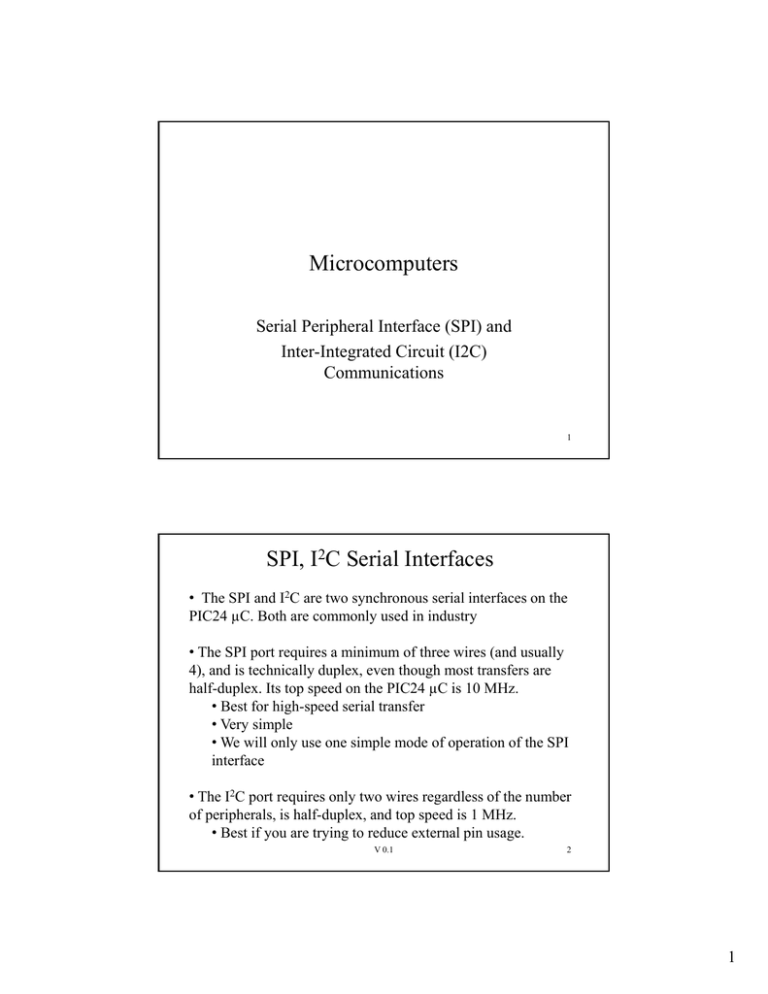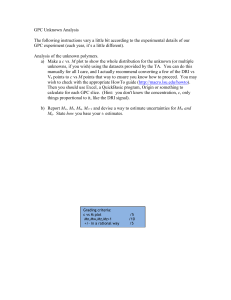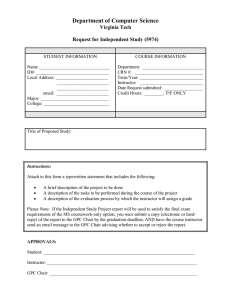
Microcomputers
Serial Peripheral Interface (SPI) and
Inter-Integrated Circuit (I2C)
Communications
1
SPI, I2C Serial Interfaces
• The SPI and I2C are two synchronous serial interfaces on the
PIC24 µC. Both are commonly used in industry
• The SPI port requires a minimum of three wires (and usually
4), and is technically duplex, even though most transfers are
half-duplex. Its top speed on the PIC24 µC is 10 MHz.
• Best for high-speed serial transfer
• Very simple
• We will only use one simple mode of operation of the SPI
interface
• The I2C port requires only two wires regardless of the number
of peripherals, is half-duplex, and top speed is 1 MHz.
• Best if you are trying to reduce external pin usage.
V 0.1
2
1
Serial Peripheral Interface (SPI)
3
Copyright Delmar Cengage Learning 2008. All Rights Reserved.
From: Reese/Bruce/Jones, “Microcontrollers: From Assembly to C with the PIC24 Family”.
V 0.1
SPI
Transmission
Formats
CKP – clock
polarity.
CKE – controls
which edge
output data is
transmitted on.
Which format is used
depends on
peripheral.
CKP =0, CKE = 1
seems common.
V 0.1
Copyright Delmar Cengage Learning 2008. All Rights Reserved.
4
From: Reese/Bruce/Jones, “Microcontrollers: From Assembly to C with the PIC24 Family”.
2
SPIx Block Diagram for PIC24 µC
5
Copyright Delmar Cengage Learning 2008. All Rights Reserved.
V 0.1
From: Reese/Bruce/Jones, “Microcontrollers: From Assembly to C with the PIC24 Family”.
SPI C Functions
void checkRxErrorSPI1() {
In pic24_spi.c, pic24_spi.h
if (SPI1STATbits.SPIROV) {
//clear the error
SPI1STATbits.SPIROV = 0;
reportError("SPI1 Receive Overflow\n");
}
}
Only function needed besides configuration
uint16 ioMasterSPI1(uint16 u16_c) {
checkRxErrorSPI1();
_SPI1IF = 0; //clear interrupt flag since we are about to
// write new value
SPI1BUF = u16_c;
while (!_SPI1IF) { //wait for operation to complete
doHeartbeat();
}
return SPI1BUF; //return the shifted in value
}
Must ALWAYS read the input buffer or
SPI overflow can occur!
6
V 0.1
3
I2C Serial Interfaces
• I2C is a synchronous serial interface on the PIC24
µC
• Commonly used in industry
• The I2C port requires only two wires regardless of
the number of peripherals, is half-duplex, and top
speed is 1 MHz.
• Best if you are trying to reduce external pin usage.
7
Inter-Integrated Circuit (I2C) Bus
Copyright Delmar Cengage Learning 2008. All Rights Reserved.
8
From: Reese/Bruce/Jones, “Microcontrollers: From Assembly to C with the PIC24 Family”.
4
I2C Bus Signaling
Every byte transferred takes 9 bits because of
acknowledgement bit.
9
I2C on the PIC24 µC
10
5
Support Functions – I2C Operations
These are primitive operations.
11
Support Functions – I2C Transactions
These are use the primitive operations to read/write 1 or more
bytes to a slave.
12
6
I2C Read/Write Transactions
13
Example primitive function
I2C1BRG = ((Fcy/FSCL)-(Fcy/10,000,000))-1
14
7
Transactions
Used for block data
Transfers.
15
PIC24 μC Master to 24LC515 Serial EEPROM
EEPROM is 64 K x 8 , internally arranged as
two separate 32 K x 8 memories.
NOTE: The diagram above is a logical layout,
not the physical pinout, shown on the right.
16
8
24LC515 I2C Address Format, Write Operation
Most efficient to
write 64 bytes at
a time as write
takes 3 – 5 ms to
complete.
Poll device to see
when the write is
finished.
17
24LC515 I2C Read Operation
We will do this to read the device, and always will read 64 bytes at a time.
18
9
Support Functions
Poll device
to see when
the write is
finished.
Write 64
bytes in
*pu_buf to
device
19
Support Functions
Read 64 bytes from device, return in *pu_buf
20
10
Testing the
24LC515
In write mode, read 64
characters from the console,
write to the 24LC515
In read mode, read 64
characters from the memory,
write to the console.
21
Test Output
22
11
What do you have to know?
•
•
•
•
•
Basic SPI Bus Operation
I2C Bus operation
I2C primitive function operation and usage
I2C Transaction function operation and usage
24LC515 EEPROM Operation
23
12


